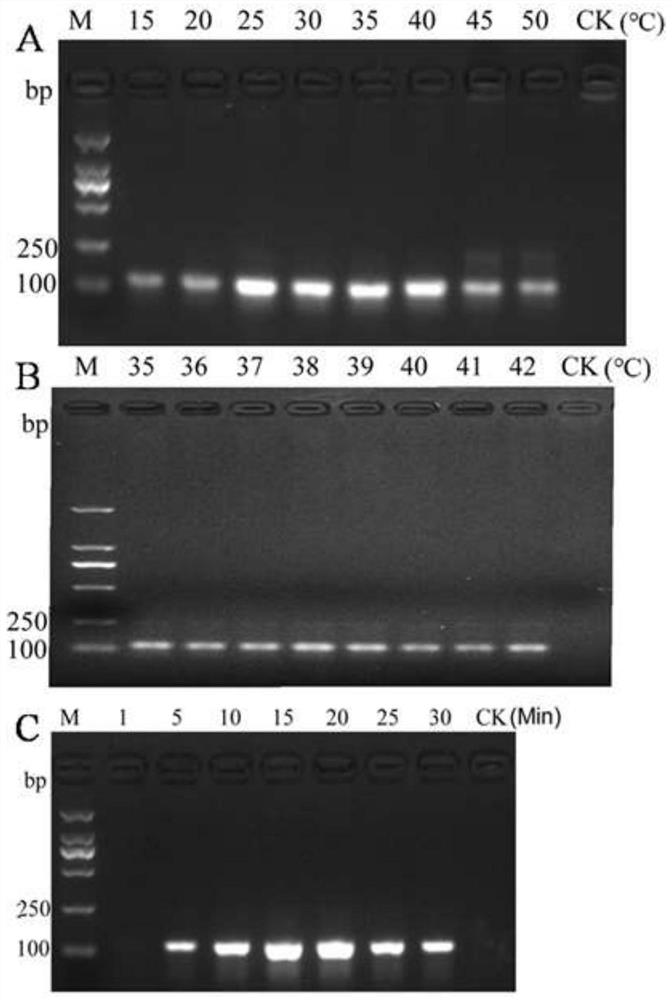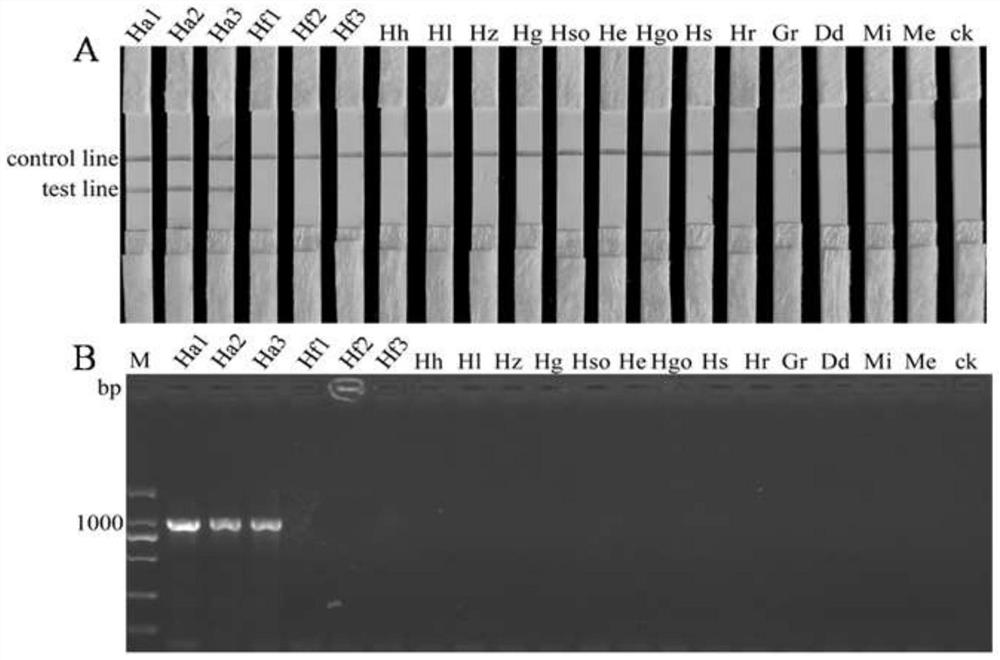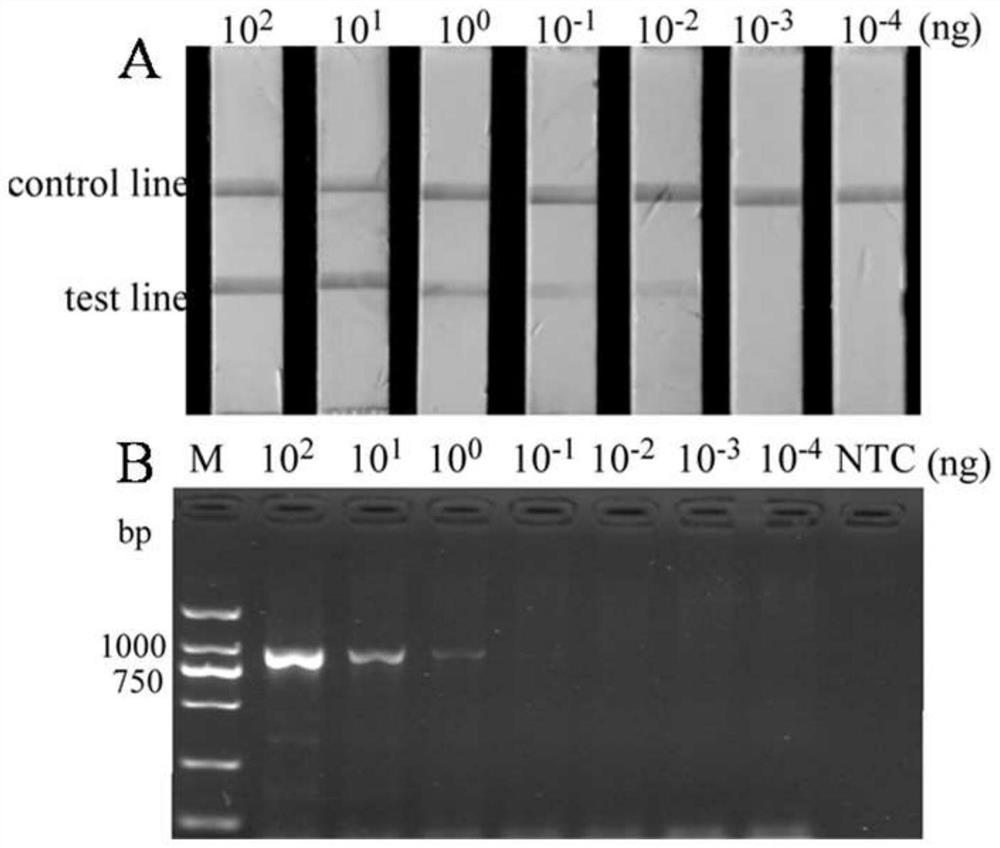RPA (recombinase polymerase amplification) primer, probe and kit for detecting heterodera avenae and application
A cereal cyst nematode technology and a kit are applied in the fields of biochemical equipment and methods, DNA/RNA fragments, recombinant DNA technology, etc., which can solve the problems such as no report on the cereal cyst nematode, and achieve intuitive sensitivity and specificity. Strong and sensitive effect
- Summary
- Abstract
- Description
- Claims
- Application Information
AI Technical Summary
Problems solved by technology
Method used
Image
Examples
Embodiment 1
[0038] The extraction of embodiment 1 cereal cyst nematode DNA
[0039] Pick a single second-instar larva or cyst into a 0.2 mL PCR tube, add 20 μL DNA isolation buffer, including 10 μL double-distilled water (ddH 2 O), 7 μL PCR buffer [100 mM Tris-HCl (pH8.9), 500 mM KCl and 15 mM MgCl 2 ] (Takara-Bio, Shiga, Japan) and 3 μL Protein K [600ng / mL] (Solarbio, Beijing, China), DNA isolation methods such as Peng et al. (Peng H, Qi X, Peng D, et al. Sensitive and Direct Detection ofHeterodera filipjevi in Soil and Wheat Roots by Species-Specific SCAR-PCRAssays.[J].Plant Disease, 2013,2(23):1-28), using DNeasy Blood&Tissue Kit (Qiagen, Hilden, Germany), according to manufacture Pure genomic DNA was isolated from 5000 second instar larvae according to the description of the merchant. According to the product instructions, use Soil DNA Isolation Kit (No.12988-10, Qiagen) was used to extract soil DNA (sDNA) from artificially inoculated soil and natural soil in the field. DNA was...
Embodiment 2
[0040] The establishment of embodiment 2RPA technique detection gramineous cyst nematode method
[0041] RPA primers and probes were designed according to the instructions of the DNA Constant Temperature Rapid Amplification Kit (see Table 2).
[0042] Primer design: Design a sequence with a length of 100bp-300bp according to the specific SCAR sequence (JQ405270.1) of the cereal cyst nematode genome, and mark a modified gene (commonly used biotin) at the 5' end of the downstream primer. Fluorescent probe design: Between the upstream and downstream primers, design a 46-52bp complementary sequence to the target fragment. The 5' end is labeled with a fluorescent group, and the middle position of the 5' and 3' ends is marked with a dSpacer (THF) as the recognition site of nfo; the 3' end is marked with a modified gene (amine group, phosphate group or C3- Spacer phosphoramidite).
[0043] Table 2 Primers, probes and amplified product sequences
[0044]
[0045] Using the speci...
Embodiment 3
[0047] The establishment and optimization of embodiment 3RPA-LFD system
[0048] On the basis of Example 2, 8 different reaction temperatures (15, 20, 25, 30, 35, 40, 45 and 50°C) and 7 reaction times (1, 5, 10, 15, 20, 25 and 30 min). In order to further determine the optimal reaction temperature, RPA was carried out at 8 different temperatures of 35, 36, 37, 38, 39, 40, 41 and 42°C, using a single second-instar larva of the cereal cyst nematode H. avenae as a template Amplify.
[0049] The result is as figure 1 As shown, bands can be observed in a wide temperature range from 15°C to 50°C during electrophoresis detection ( figure 1 A). Between 35°C and 40°C, the brightness of the bands did not increase significantly ( figure 1 B). In addition, seven RPA reactions were carried out at 40°C for different times, and the results showed that when the reaction time was 5 to 30 minutes, bands could be seen ( figure 1 C), the optimum reaction time is 10 to 30 minutes.
PUM
 Login to View More
Login to View More Abstract
Description
Claims
Application Information
 Login to View More
Login to View More - R&D
- Intellectual Property
- Life Sciences
- Materials
- Tech Scout
- Unparalleled Data Quality
- Higher Quality Content
- 60% Fewer Hallucinations
Browse by: Latest US Patents, China's latest patents, Technical Efficacy Thesaurus, Application Domain, Technology Topic, Popular Technical Reports.
© 2025 PatSnap. All rights reserved.Legal|Privacy policy|Modern Slavery Act Transparency Statement|Sitemap|About US| Contact US: help@patsnap.com



